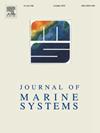Drivers of the unprecedented coastal marine heatwaves along Fujian and Zhejiang provinces, China
IF 2.5
3区 地球科学
Q2 GEOSCIENCES, MULTIDISCIPLINARY
引用次数: 0
Abstract
In recent decades, coastal marine heatwaves (MHWs) have intensified due to global warming, causing severe impacts on coastal marine ecosystems. In September and October 2021, significant reductions in seaweed production were observed along the coasts of Fujian (−19.23 %) and Zhejiang (−3.27 %) Provinces in China, which may be related to unprecedented coastal MHWs. This study utilizes three high-resolution satellite sea surface temperature (SST) datasets together with oceanic and atmospheric reanalysis products to examine the characteristics and mechanisms of these MHWs. Our analysis reveals that the record-breaking MHWs occurred primarily from September 21 to October 23, with an average intensity of up to 4 °C and lasting nearly the entire month of October. Mixed layer heat budget assessments indicate that net surface heat flux was the key factor influencing temperature changes (Corr = 0.71, p < 0.01). The positive net surface heat flux in September, driven by increased solar shortwave radiation, resulted from the intensification and westward expansion of the western Pacific subtropical high (WPSH). We emphasize that understanding the mechanisms behind the anomalous WPSH in autumn is vital for mitigating climate risks to seaweed production along the Fujian and Zhejiang coasts in the context of global warming.

中国福建和浙江沿海前所未有的海洋热浪的驱动因素
近几十年来,由于全球变暖,沿海海洋热浪加剧,对沿海海洋生态系统造成了严重影响。2021年9月和10月,中国福建省(- 19.23%)和浙江省(- 3.27%)沿海的海藻产量显著减少,这可能与前所未有的沿海强热带风暴有关。本研究利用3个高分辨率卫星海表温度(SST)数据集,结合海洋和大气再分析产品,研究了这些强震的特征和机制。我们的分析表明,破纪录的MHWs主要发生在9月21日至10月23日,平均强度高达4°C,几乎持续整个10月。混合层热收支评估表明,净地表热通量是影响温度变化的关键因素(Corr = 0.71, p <;0.01)。西太平洋副热带高压(WPSH)的增强和向西扩展导致9月地表净热通量为正,主要受太阳短波辐射增加的驱动。我们强调,在全球变暖的背景下,了解秋季海面高度异常背后的机制对于减轻福建和浙江沿海海藻生产的气候风险至关重要。
本文章由计算机程序翻译,如有差异,请以英文原文为准。
求助全文
约1分钟内获得全文
求助全文
来源期刊

Journal of Marine Systems
地学-地球科学综合
CiteScore
6.20
自引率
3.60%
发文量
81
审稿时长
6 months
期刊介绍:
The Journal of Marine Systems provides a medium for interdisciplinary exchange between physical, chemical and biological oceanographers and marine geologists. The journal welcomes original research papers and review articles. Preference will be given to interdisciplinary approaches to marine systems.
 求助内容:
求助内容: 应助结果提醒方式:
应助结果提醒方式:


